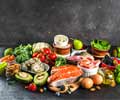Changing products on offer in shops and restaurants can lead to a diet that reduces inequalities and protect the environment.

Along with measures such as higher taxes and marketing restrictions on unhealthy products. Availability interventions have the potential to contribute to population health and net-zero goals. But they remain largely overlooked by policymakers.
So, they set out to summarise the evidence supporting availability interventions in a form useful to policymakers.
They searched the scientific literature and identified nine real-world studies (including four new studies) showing consistent and often substantial effects of availability interventions on consumer selection of healthier or more sustainable options, with no evidence of adverse effects, including increasing health inequalities.
For example, increasing the proportion of vegetarian meal options in a cafeteria from 25% to 50% decreased the selection of meat meals by almost eight percentage points (from 81% to 73%).
Similarly, increasing the proportion of lower energy food options available in cafeterias from 42% to 50% reduced the calories purchased per transaction by almost five percent compared with baseline (from 384 to 366 kcal).
Advertisement
Some uncertainties, such as whether these findings can be applied to low- and middle-income countries, and the impact of population preferences (social norms) on what we eat.
Advertisement
Source-Medindia















